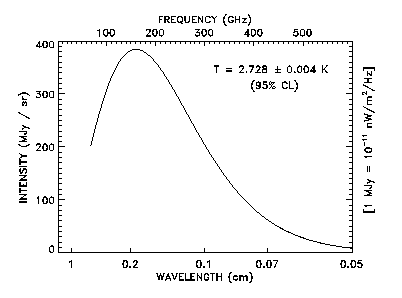

The universe is filled with the remnant heat from the Big Bang called the "cosmic microwave background radiation." Today, this radiation is very cold: only 2.728 degrees above absolute zero. It fills the universe and can be seen everywhere we look.

Since light travels at a finite speed, astronomers observing distant objects are looking into the past. Most of the stars that are visible to the naked eye in the night sky are 10 to 100 light years away. Thus, we see them as they were 10 to 100 years ago. We observe Andromeda, the nearest big galaxy, as it was three million years ago. Astronomers observing distant galaxies with the Hubble Space Telescope can see them as they were only a few billion years after the Big Bang. (Most cosmologists believe that the universe is between ten and twenty billion years old.)
By observing the cosmic microwave background, cosmologists can study the physical conditions only a few hundred thousand years after the Big Bang, long before stars or galaxies even existed. By study these physical conditions, we can learn about the structure of the universe, its origin and evolution.

One of the basic predictions of the Big Bang theory is that the universe is expanding. Astronomers can look at distant galaxies can directly observe this expansion, originally detected by Edwin Hubble. Since the universe is expanding, it was denser and hotter in the distant past. When the visible universe was half its present size, the density of matter was eight times higher and the cosmic microwave background was twice as hot. When the visible universe was one hundredth of its present size, the cosmic microwave background was a hundred times hotter (273 degrees above absolute zero or 32 degrees Fahrenheit, the temperature at which water freezes to form ice on the Earth's surface). In addition to this cosmic microwave background radiation, the early universe was filled with hot hydrogen gas with a density of about 1000 atoms per cubic centimeter (a teaspoon is roughly 3 cubic centimeters).
The early universe was a very hot place. When the visible universe was one hundred millionth its present size, its temperature was 273 million degrees above absolute zero and the density of matter was comparable to the density of air at the Earth's surface. At these high temperatures, the hydrogen was completely ionized into free protons and electrons. Most of the Deuterium and Helium in the universe was synthesized at these high temperatures.
Since the universe was so very hot through most of its early history, there were no atoms in the early universe, only free electrons and nuclei. (Nuclei are made of neutrons and protons). The cosmic microwave background photons easily scatter off of electrons. Thus, photons wandered through the early universe, just as optical light wanders through a dense fog.
This process of multiple scattering produces what is called a "thermal" or "blackbody" spectrum. This thermal spectrum, predicted by the Big Bang theory, was measured with tremendous accuracy by the FIRAS detector aboard NASA's COBE satellite.

Eventually, the universe cooled sufficiently that protons and electrons could combine to form neutral hydrogen. This was thought to occur roughly 500,000 years after the Big Bang when the universe was about one thirteen hundredth its present size. Cosmic microwave background photons interact very weakly with hydrogen.
The behavior of cosmic microwave background photons moving through the early universe is analogous to the propagation of optical light through the Earth's atmosphere. Water droplets are very effective at scattering light, while optical light moves freely through clear air. Thus, on a cloudy day, we can look through the air out towards the clouds, but can not see through the opaque clouds. Cosmologists studying the cosmic microwave background radiation can look through much of the universe back to when it was opaque: a view back to 500,000 years after the Big Bang.

One of the most striking features about the cosmic microwave background is its uniformity. Unlike the optical sky with many bright regions, the cosmic microwave background temperature varies very little across the sky. While the Big Bang theory explains the origin of the cosmic microwave background radiation, it does not explain its uniformity. The theory of Inflation was proposed to explain this uniformity and to resolve other paradoxes associated with the Big Bang.
Only with very sensitive experiments, such as COBE and MAP, can cosmologists detect fluctuations in the cosmic microwave background. By studying these fluctuations, cosmologists can learn about the origin of galaxies and large scale structures of galaxies and they can measure the basic parameters of the Big Bang theory:

 Back to the Introduction to Cosmology Page
Back to the Introduction to Cosmology Page
 Back to the MAP Home Page
Back to the MAP Home Page
 David N. Spergel / dns@astro.princeton.edu
David N. Spergel / dns@astro.princeton.edu